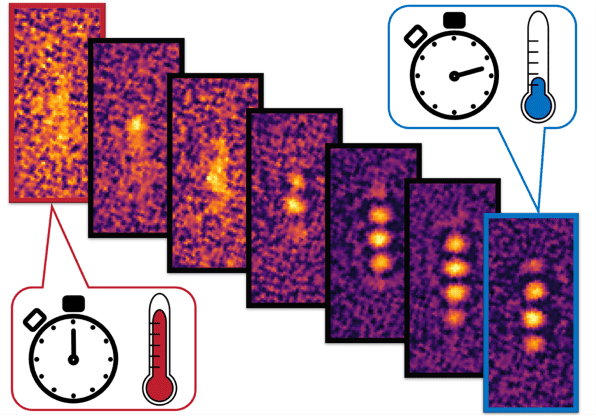Cool, cooler, supersolid: Images of the dipolar atoms cooling down and forming the supersolid state. As the system cools, periodic density peaks emerge. (Courtesy: Maximilian Sohmen)”>
Supersolids – materials that exhibit both spatial ordering (seen in solids) and lossless flow (seen in superfluids such as helium-II) – are poorly understood at the finite temperatures that prevail in real-world experiments. Physicists at the Institute for Quantum Optics and Quantum Information (IQOQI) in Innsbruck, Austria have now furthered our understanding of this exotic quantum phase of matter by experimentally probing the finite-temperature behaviour of a supersolid over its full “life cycle”, observing its formation, dynamics, and subsequent destruction.
When supersolids were first proposed in the 1960s, they appeared to contradict the idea that superfluidity – a state in which a material has zero viscosity and thus flows without loss of energy – can only exist when the system is in a fluid-like state. In 2017, however, research groups at MIT and ETH Zürich observed some properties of supersolids for the first time in a Bose-Einstein condensate (BEC) – a dilute gas of ultracold atoms deep in the quantum regime.
More recently, the Innsbruck team (simultaneously with two research groups from Universität Stuttgart and CNR-INO, Pisa) observed supersolidity in a dipolar BEC – a special type of condensate where highly magnetic atoms exhibit dipolar interactions, leading to a favourable dispersion relation. This type of condensate offers an ideal playground to create and investigate supersolidity because in a dipolar BEC, the interactions themselves create the crystalline modulation. This contrasts with previous experiments in which the modulation was imposed via laser light.
Exploring temperature effects
While the behaviour of supersolids at zero temperature is well-described theoretically, good models of finite-temperature supersolids with realistic particle numbers remain elusive due to the added complexity of thermal effects. In the current work, which is published in Physical Review Letters, the Innsbruck team bypassed this challenge and used their experiment to investigate the role temperature plays in the formation, dynamics, and subsequent death of supersolids.
“Back in 2019, we observed that an ultracold gas of dipolar particles can spontaneously break two symmetries: the one that leads to superfluidity (known as gauge invariance), and the one that defines solidity by creating periodic density waves (known as translational symmetry),” explains group leader Francesca Ferlaino. “While the first broken symmetry is well studied since similar physics occurs in other Bose-Einstein condensates, the second broken symmetry is rather unique in quantum gases.” The central focus of the Innsbruck work was to answer the question, how do these symmetries break? In other words, does the solidity arise first or the superfluidity, or both simultaneously?

Supersolid behaviour spotted in dipolar quantum gases
The dipolar system was prepared in an elongated cigar shaped trap at a relatively high temperature. It was then cooled until the quantum effects necessary for supersolidity became dominant. Via high-resolution imaging of the system, the team directly witnessed the density peaks – a signature of solidity – that form in the condensate. To measure the system’s superfluid nature, the atoms were released, and images taken after a short expansion. This allowed the researchers to extract the relative phase across the condensate – a key ingredient for establishing superfluidity.
“Our most striking result is the observation which shows that when cooled down, the system first breaks translational symmetry entering a ‘crystal’-type state,” says Ferlaino. “Then, when further proceeding in the cooling trajectory, the system builds a macroscopic coherence to create superfluid properties hence becoming a supersolid state.”
Expanding the dimensionality
These experiments have not only achieved a deeper understanding of supersolids but paved the way for better theoretical interpretation. Matthew Norcia, a postdoc at IQOQI and a co-author of the paper, says that the next step will be to extend their studies beyond one-dimensional supersolids. “This is an exciting development because going to two-dimensional supersolids should enable us to study phenomena such as vorticity, which is expected to have quite different properties compared to unmodulated states, such as regular superfluids,” he says.
